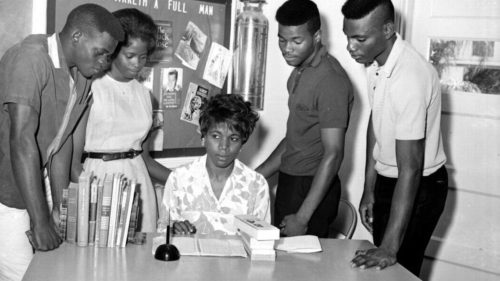by Tori Chasey Edwards
January 21, 2018

Honor students gather at Lincoln Memorial High School in Palmetto.
The 1954 Supreme Court decision in the case of Brown vs. The Board of Education transformed life in Manatee County — even if it took decades for these changes to take effect. Thurgood Marshall and the NAACP Legal Defense and Education Fund handled this case (really five different cases that were all rolled into one since they dealt with the same issue) by proving that “separate educational facilities are inherently unequal.” Manatee County schools were no exception to this rule.
A 1954 Bradenton Herald article notes that Manatee County educational facilities were given lower accreditation ratings because of inadequate facilities for blacks, which produced students “more than a year below the norm established for the grade levels.” Just a few weeks before the Brown vs. Board of Education decision, the Manatee County School Board declared a three-day school holiday for black students so that they could help harvest a bumper crop of tomatoes. School board member J.P. Harllee, a major grower and packing house operator, made the motion to suspend school.
About the same time that the highest court in the land declared separate but equal to be unequal, Manatee County was working hard to bring equality to the two separate systems. In June 1955, Manatee County School Superintendent Blackburn told a gathering of other superintendents in Tallahassee that integration probably wouldn’t be a problem in our county because local black citizens were mostly concerned “in seeing the construction of a new elementary school and the expansion of a second school plant.”
Over the next few years, the Manatee County School Board made strides to improve the education of black students, but the cost of duplicating programs offered at white schools was prohibitive. In 1961, the federally sponsored Vocational Education Act was utilized to provide Commercial Business Training (CBT) classes for girls interested in becoming secretaries, filing clerks, or stenographers at all-black Lincoln Memorial High School. In a 1970 interview, Oscar Sanders, former assistant principal at Lincoln Memorial, noted that “We never had the basic equipment needed to operate a CBT program. Most of the typewriters and desks were used in the white high schools before they were sent to Lincoln.”
While many of us born post-integration see this as a moral issue, arguments to tolerate desegregation for economic reasons were often more successful in changing Southern minds. Our community has always depended upon tourism dollars and people on both sides of the issue tried to keep local strife off of a national stage. Gov. Leroy Collins, who held office in Florida from 1955 until 1961 argued that “the greatest roadblock to progress is the disease of racial intolerance.” Large-scale protests and race riots might make an interesting segment on the nightly news, but they don’t make people want to vacation here! An effort to portray the Tampa Bay area as a sunny utopia to tourists kept a lid on much of the violence and ugliness that characterized the civil rights movement.
To learn more about our local struggle for equality, visit the Palmetto Historical Park to see the special exhibit Beaches, Benches & Boycotts: The Civil Rights Movement in Tampa Bay. Coinciding with this special exhibit is The Art of the Florida Highwaymen exhibit and, in the Agricultural Museum (located in the Palmetto Historical Park), the Florida’s Black Cowboys: Past and Present exhibit. To learn more about the integration of Manatee County schools from the people who experienced it firsthand, attend the Through the Tunnel: Screening & Panel Discussion.
